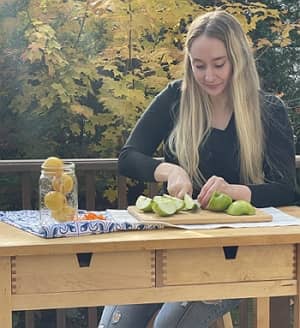Learn how to start meal planning with these easy tips. Discover the health and financial benefits of cooking at home with sustainable, eco-friendly choices.
The term meal planning gives most of us the ick. It sounds boring, tedious, and restrictive. And honestly—why bother? If there’s nothing prepped, we can just order from Seamless or UberEats.
That works once or twice, but when it becomes a habit—ordering three, four times a week—it starts showing up. On our credit card statements. In our energy levels. In how we feel.
Takeout and convenience foods aren’t nourishment. Sure, they may taste good, and they’re quick and easy, but they’re a temporary fix—not a solution. Real nourishment comes from food we prepare ourselves—whole, high-quality ingredients, minimally processed, made with care.
Takeout and restaurant meals are meant for art and experience. When they become our everyday fuel, that’s when we lose the plot.
Contents
The Benefits of Meal Planning
To enjoy nourishing meals, we need a plan—we need to set ourselves up for success. Meal planning helps save money, control portions, and gives you a flexible system that fits your lifestyle, no matter where you are.
Whether you’re meal planning for vacation, accommodating cultural needs like kosher eating, or just trying to make home cooking easier, this guide is designed to be a plug-and-play solution for you.
So, how can meal planning and prep feel simpler? Let’s break it down.
The Four Principles of Meal Planning
There are four steps to successful meal planning. Plan, Shop, Prep, Cook.
Plan
Arguably the hardest phase—but also the most important. I recommend keeping a Google Doc or spreadsheet as your meal planning diary, a space to track ideas, refine your process, and improve efficiency over time.
Having a plan means you won’t have to scramble in the moment, wondering what to eat or how to throw something together. Instead, you’re in control—of your time, your meals, and the details that matter most.
This is where you map out meals for yourself and your family, taking preferences and nutritional needs into account. Whether you’re planning by macronutrients, micronutrients, or just focusing on balance, this stage sets the foundation. When done right, it transforms your home into a space that supports easy, stress-free meal prep—week after week.
<<Get your step-by-step guide to the Plan phase and your weekly menu here>>
Shop
Once your menu is set, it’s time to create a grocery list. An organized list makes shopping more efficient, and over time, you’ll only need to replenish perishables and a few staples.
Keep these tips in mind:
- Plan to minimize food waste.
- Write your list down—don’t rely on memory.
- Organize your list based on your store’s layout for a smoother trip.
- Have a system for putting groceries away efficiently when you get home.
A little planning at this stage makes the rest of the process so much easier.
<<Get your in-depth guide to the Shop phase here>>
Prep
Prep is a rhythm. Once you’re home from the store, refer back to your plan to decide what needs to be prepped now and what will be stocked away. Most importantly, break down the recipe into manageable steps.
The first few times you make a recipe, you’ll likely need to follow the directions closely. But as you repeat the process, it becomes easier, faster, and more intuitive. Over time, as you get comfortable with certain meals, you’ll save both time and energy—turning meal prep into a seamless part of your routine.
Cook
Part of building confidence in the kitchen is engaging all your senses—learning how dishes taste, smell, feel, and look—and even recognizing their sounds! As you become more familiar with these details, you’ll develop the intuition to trust your gut when making decisions or fixing mistakes.
Mistakes in cooking and baking are inevitable—they’re part of the process! But the more you understand how food cooks and reacts, the better equipped you’ll be to course-correct when needed. With time, these small challenges will feel less like setbacks and more like learning opportunities.
<<Get your in-depth guide to the Prep & Cook phase here>>
Building a System
The goal of meal planning isn’t perfection—it’s creating a system that works for you. And like any good system, it should be fluid—evolving as you learn what works and what doesn’t.
Take time to reflect and review your plan regularly. Ask yourself:
- Did I enjoy the meals I planned?
- Did I make too much or too little food?
- Was my grocery list efficient?
- Did I actually have time for the prep I planned?
Trial and error are part of the process. As you refine your approach, meal planning will feel less like a chore and more like second nature. The key is flexibility—adapting and adjusting based on your needs, preferences, and lifestyle.
With consistency, you’ll build a system that saves time, reduces stress, and makes nourishing meals an easy, effortless part of your routine.
Key Takeaways
- Meal planning isn’t about restriction—it’s about creating ease and flexibility.
- A successful meal planning system includes four essential steps:
- Plan – Map out meals that fit your lifestyle and nutritional needs.
- Shop – Create an organized grocery list to streamline shopping.
- Prep – Establish a prep routine to make cooking easier.
- Cook – Build confidence in the kitchen by learning from experience.
- Meal planning is an evolving process. Trial and error help refine your system so it becomes second nature.
To learn more about what Dining With Nature offers for nutrition care – hit the Explore The DWN Programs button below or take a look at our Services page.
Disclaimer: The information in this post is for general educational purposes only and should not be considered personalized medical advice or a substitute for professional guidance. Always consult with your doctor or a registered dietitian before making any changes to your diet, lifestyle, or supplement routine.


